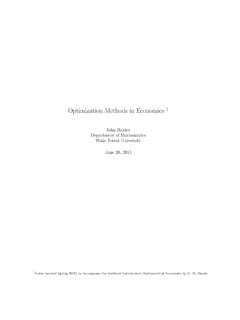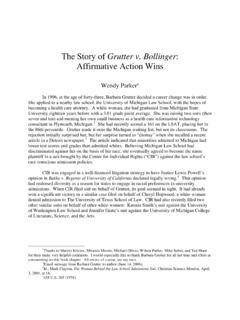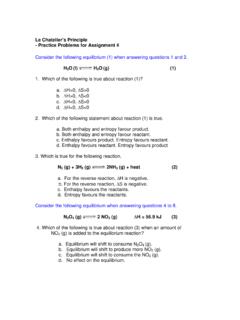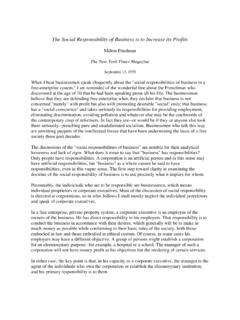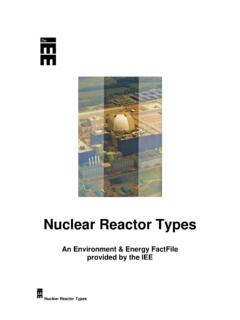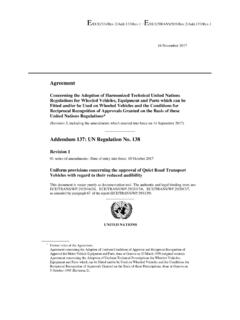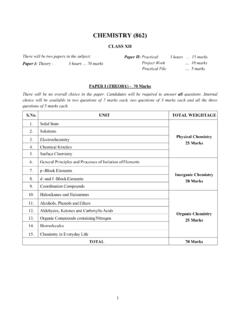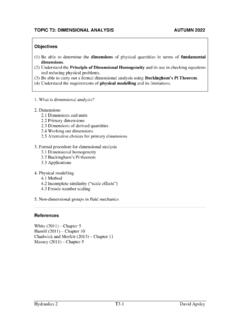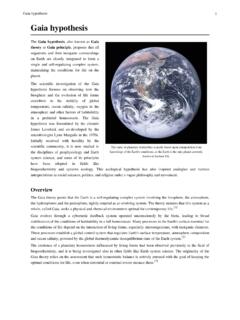Transcription of Sputtering - Wake Forest University
1 Sputtering Vacuum Evaporation Recap Use high temperatures at high vacuum to evaporate (eject) atoms or molecules off a material surface. Use ballistic flow to transport them to a substrate and deposit. Film uniformity can be an issue. Alloy evaporation is very complicated and in most cases, not possible. An Alternative Method Instead of using heat to eject material from a source, we can Substrate bombard them with high speed particles. The momentum transfer from the particles to the surface atoms can impart enough energy to allow the surface atoms to escape. Source Once ejected, these atoms (or molecules) can travel to a substrate and deposit as a film. There are several considerations here: Creating, controlling and directing a high speed particle stream.
2 Interaction of these particles with the source surface and emission yields. Deposition of the emitted atoms on the substrate and film quality. Some Terminology Atomic particles can best be easily controlled by electromagnetic methods if they are charged. A weakly charged gas of particles that exhibit collective behavior is called a plasma. The source material is called the target and the emitted atoms or molecules are said to be sputtered off. Sputtering So in Sputtering , the target material and the substrate is placed in a vacuum chamber. -V. A voltage is applied between them so that the target is the Target (cathode). cathode and the substrate is attached to the anode.
3 Plasma Substrates A plasma is created by ionizing a Sputtering gas Anode (generally a chemically inert, heavy gas like Argon). The Sputtering gas bombards Sputtering gas the target and sputters off the material we'd like to deposit. Generating and Controlling the Plasma Ions can be generated by the collision of neutral atoms with high energy electrons. The interaction of the ions and the target are determined by the velocity and energy of the ions. Since ions are charged particles, electric and magnetic fields can control these parameters. The process begins with a stray electron near the cathode is accelerated towards the anode and collides with a neutral gas atom converting it to a positively e + A 2e + A+.
4 Charged ion. The process results in two electrons which can then collide with other gas atoms and ionize them creating a cascading process until the gas breaks down. The breakdown voltage depends on the pressure in the chamber and the distance between the anode and the VB. cathode. At too low pressures, there aren't enough collisions between atoms and electrons to sustain a plasma. At too high pressures, there so many collisions that electrons do not have enough time to gather energy between collisions to be able to ionize the atoms. Pd Glow Discharge Formation Initially the current (charge flow) is small. As charges multiply the current increases rapidly but the voltage, limited by supply, remains constant.
5 Eventually, there are enough ions and charges for the plasma to be self-sustaining. Some of the electron-atom collisions will produce light instead of electrons and ions and the plasma will also glow accompanied by a voltage drop (normal glow). If the input power is increased further, the current density becomes uniform across the cathode and we'll be in the abnormal discharge regime. This is where Sputtering operates. The Glow Discharge Aston Dark Substrate Space Low energy electrons and high energy Anode Dark ions Space Cathode (-) Anode (+). Positive Cathode Glow Faraday Main plasma Glow Dark Space Cathode region Large field Dark Space Negative Electron Uniform field strength Electrons Glow energy is strength Many have too much Due to reduced from Equal collisions with energy reduced the collisions in number of the cathode No light density, the negative electrons and leads to high emission due electric field glow region ions intensity glow to mismatch of strength electron becomes weak energies to Electrons ionization have the right levels energy to cause excitation Plasma Pressures Unless there are enough collisions, the plasma will quickly die.
6 In order to have a self-sustaining plasma, each electron has to generate enough secondary emission. Since we want collisions to occur, the pressure can not be too low. The mean free path should be a tenth or less than the typical size of the chamber. Also, since we want the electrons to gain enough energy between collisions, the pressure can not be too high. This means discharge tube pressures around 10-1000. mTorr and plasma densities around 1010 1012 cm-3. Ion-Surface Interactions When ions bombard a surface, several things can happen: Reflection Sticking (adsorption). Sputtering Ion implantation Chemical reactions Electron and photon emission The ion beam energy is the critical parameter.
7 < 5 eV : Adsorption or reflection 5 - 10 eV : Surface damage and migration 10 - 3 keV : Sputtering > 10 keV : Ion implantation How Ions Sputter Atoms When ions collide with surface atoms on the target, the energy transfer can knock some of these atoms off the surface. The key principle is energy and momentum conservation. In any collision, momentum is conserved. If the collision is elastic, kinetic energy is also conserved. The energies required for Sputtering are much higher than lattice bonding or vibrational energies (which are the causes of inelastic interactions), therefore Sputtering collisions can be considered elastic. Momentum and Energy m1,v1i m1,v1f m2,v2f Momentum Kinetic Energy 1 2.
8 P = mv K = mv m2,v2i 2. p i = m1 v1i + m2 v 2i = p f = m1 v1 f + m2 v 2 f Ki =. 1. 2. (. m1v1i + m2 v2i 2 2. ) = Kf =. 1. 2. (. m1v1 f + m2 v2 f 2 2. ). Maximum energy transfer in such a collision occurs when the masses are equal. Energy Transfer Between Two Masses in the Forward Direction K2 K2 4m1m2. cos 2. K1/K2.. K1 m1. m2. K1 (m1 + m2 )2 m1/m2. Direction of Emission For normal incidence of ions, the primary collision can not eject an atom off the surface. However, the secondary collision can. At oblique incidence, primary collisions can result in ejection. Think billiard balls. Various Sputtering Regimes Single Knock-On The initial ion-surface collision sets target atoms in motion.
9 If enough energy is transferred, binding forces can be overcome. Typical threshold energies are in the 10 - 30 eV range. Linear Collision Cascade At higher ion energies (100. eV - 10 keV) recoil is minimal and a cascading effect produces Sputtering . Sputter Yield Number of sputtered atoms S=. Number of incident ions S. S depends on type of target atom binding energy of target atoms ~1000 E (eV). relative mass of ions and atoms S ions incident ion energy . angle of incidence of ions S can range from to 10 60-70. 0 90 . Angular and Energy Distribution of Ejected Atoms Sputtered atoms have relatively small energies, typically between 2 - 7 eV (in thermal evaporation, these values are even smaller, around eV).
10 The number distribution as a function of energy is Boltzmann like. The angular distribution is cosine-like and depends on ion energy, the target's type and crystallography. (Cos ) Dependence . Low ion energies, isotropic flux, better step coverage (Cosn ) Dependence . High ion energies, higher directionality, Target poor step coverage Deposition Sputtered atoms from the target make their way on to the substrate through diffusion. Ions and neutralized gas atoms may also embed on the substrate as impurities. The ions incident on the substrate may also re-sputter the surface. Chemical reactions may occur. Deposition Rate It is proportional to the Sputtering yield. An optimum pressure exists for high deposition rates.

